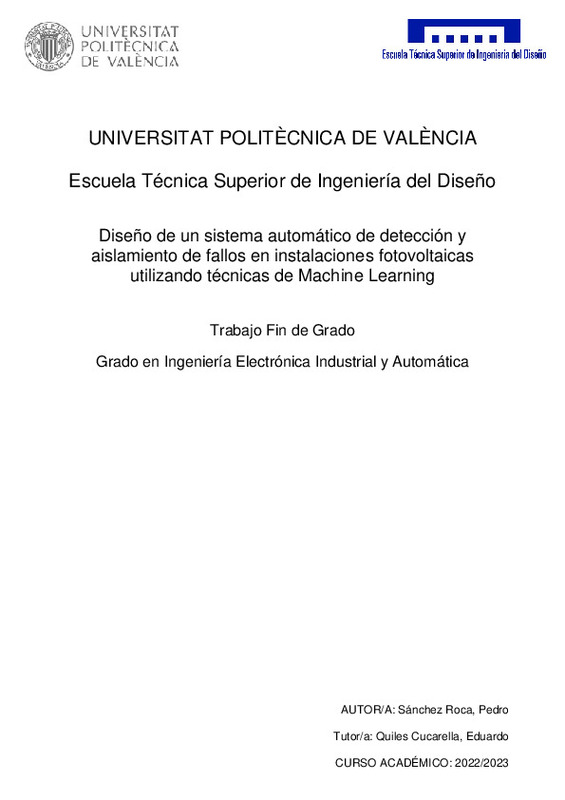|
Resumen:
|
[ES] La innovación en sistemas fotovoltaicos, su abaratamiento y el incremento en el precio de la luz han hecho que la demanda de sistemas fotovoltaicos crezca, y con ella las investigaciones que buscan tanto aumentar su ...[+]
[ES] La innovación en sistemas fotovoltaicos, su abaratamiento y el incremento en el precio de la luz han hecho que la demanda de sistemas fotovoltaicos crezca, y con ella las investigaciones que buscan tanto aumentar su eficiencia como reducir sus pérdidas. Estas pérdidas de eficiencia están causadas por el uso cotidiano, que se ha estimado que reduce su eficiencia en un 1% anual y por fallos en el sistema. La detección de estos fallos en los sistemas fotovoltaicos se ha convertido en una tarea esencial para evitar una degradación temprana de los mismos. Con una correcta predicción de los fallos, se puede conseguir un aumento en la vida útil de los sistemas y una mayor eficiencia media.
Investigaciones similares a este trabajo se han centrado en la detección de fallos y la clasificación de unos pocos tipos de estos. Como novedad, este trabajo estudia el rendimiento de los diferentes modelos disponibles para detectar y clasificar hasta siete tipos de fallos diferentes, incluido el sombreado parcial, que es la principal causa de puntos calientes. Estos puntos calientes son un problema común en los paneles solares, capaz de provocar un incendio y, en el mejor de los casos, reducir drásticamente su eficiencia. Además, compara los algoritmos disponibles para detectar cada tipo de fallo, incluso teniendo en cuenta el modo de potencia del sistema. Para ello, se ha hecho uso de una base de datos obtenida de un estudio anterior. Esta base de datos fue creada utilizando un modelo de simulación diseñado en Simulink. Esta base de datos incluye siete tipos de fallos: circuito abierto, caídas de tensión, sombreado parcial, inversor, sensor de retroalimentación de corriente y controlador MPPT/IPPT en fallos del convertidor elevador. Todas estas mediciones se realizaron tanto en el modo de seguimiento de máxima potencia (¿Maximum Power Point Tracking¿, MPPT), como en modo limitado (¿Limited Power Point Tracking¿, LPPT).
Para llevar a cabo esta investigación, se ha utilizado MATLAB y un complemento llamado Classification Learner. Además de hacer uso de Excel para analizar y representar todos los datos recopilados.
Una vez hecho el estudio sobre qué modelo predictivo funciona mejor para cada caso, se propone el diseño de un dispositivo capaz de desconectar el sistema, evitando que el problema cause daños al resto de la instalación.
[-]
[EN] Innovation in photovoltaic systems, their cheapening, and the increase in the price of electricity have made the demand for photovoltaic systems grow, and with it, the researches that seek to increase their efficiency ...[+]
[EN] Innovation in photovoltaic systems, their cheapening, and the increase in the price of electricity have made the demand for photovoltaic systems grow, and with it, the researches that seek to increase their efficiency and reduce their losses. These efficiency losses are caused by everyday use, which has been estimated to reduce its efficiency by 1% per year, and system failures. Detecting these failures in photovoltaic systems has become essential to avoid their early degradation. With correct fault prediction, an increase in system life and higher average efficiency can be achieved.
Researches similar to this work have focused on fault detection and classification of a few types of faults. As a novelty, this work studies the performance of the different models available to detect and classify up to seven types of failures, including partial shading, which is the leading cause of hot spots. These hot spots are a common problem in solar panels, capable of causing a fire and, at best, drastically reducing their efficiency. In addition, it compares the algorithms available to detect each type of failure, even considering the system's power mode. For this, a database obtained from a previous study has been used. This database was created using a simulation model designed in Simulink. This database includes seven types of failures: open circuit, voltage drops, partial shading, inverter, current feedback sensor and MPPT / IPPT controller in failure of the elevator converter. All these measurements were performed in Maximum Power Point Tracking (MPPT) mode and Limited Power Point Tracking (LPPT).
To carry out this research, MATLAB and an add-on called Classification Learner were used. In addition to using Excel to analyze and represent all the data collected.
Once the study has been done on which predictive model works best for each case, a device capable of disconnecting the system is proposed, preventing the problem from causing damage to the rest of the installation.
[-]
|







